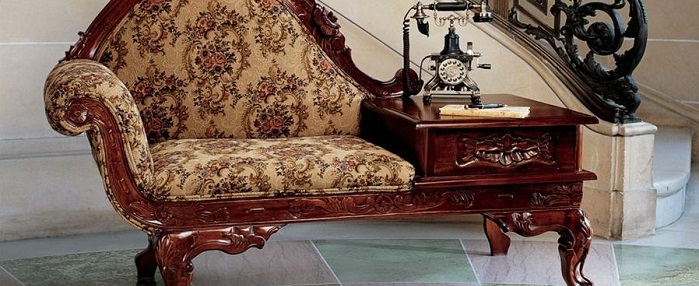In interior design, everything comes around again. These days, though, it’s easier than ever for antique elements to see a resurgence. Why? Because antique replicas have common, affordable, and easy to make. You don’t have to go hunting for an heirloom piece just to get a look you want anymore. It’s also becoming more common for designers to mix, match, and re-imagine antique elements and incorporate them into more contemporary designs. Here are a few different ways to add an antique vibe to your decor.
Replicas
Antique replicas are the next best thing to the real deal. They’re designed with history in mind; they should mimic the designs they’re based on down to the last detail, from the wood, finishes, and carvings to fabric and upholstery style. But while the phrase might make you think of big mahogany desks or intricately carved wood chairs, a “replica” can be of any type of historical design, from ornate Louis XV pieces of the mid-1700s all the way up to mid-century modern designs revived from the 1920s and 30s. Whatever the style, any replica should be more easily available than the original.
Old Fashioned Functionality
Most people think of multi-function furniture as an offshoot of modern design. But while they’re somewhat less well-known, there are many antique designs that come with added functionality. The designs are often whimsical in style, and less streamlined and compact than their contemporary equivalents, which makes them great conversation starters. A gossip bench, like this one from Toscano, is a relic of a bygone era. But it’s all the more charming for it. Similarly, Ben Franklin ladder chairs are as charming and functional as they were when they were invented.
Using Replicas As Accent Pieces
It is, of course, possible to decorate an entire room – or even your entire home – with antique replica pieces. But they’re also really excellent for use as individual accent pieces. In a transitional room, one bold replica can add a touch of sophistication without making your space feel old fashioned. A striking velvet divan can add shape and contours to a more contemporary, rectangular living room set. Similarly, a really ornately carved wood chair, stool, or table can feel like a piece of art all to itself.
Streamlined Designs
Not all so-called antique replicas copy historical designs exactly, though. In fact, with the rising popularity of a transitional style, many designers are re-imagining iconic antiques and slimming, trimming, and streamlining them down into something better suited to a contemporary home. That can mean a lot of things. Simpler lines and less ornate woodwork are common, but even something as basic as a solid-colored upholstery makes a difference. Button tufting and nailhead upholstery are particularly popular features; pair them with humbler fabrics, like linen or canvas, rather than a showy jacquard or brocade. These less authentic antiques have a more laid back feel, but still carry the sophistication of an old world style. Perfect for an elegant transitional look.
Funky Colors and Materials
On the far opposite end of the spectrum are the antique replicas from modern and contemporary designers like PolArt. These frequently have all the opulent detailing of a true antique – highly detailed woodwork, interesting silhouettes, plush padding with tufted buttons, and so on. But rather than being made of mahogany and embroidered fabric, they’re made of modern materials – like polyresin and bonded leather – in bold, vivid colors. These “replicas” are almost tongue-in-cheek, designed to be visually striking in their inherent clash of designs. The result is a look that’s more chic than sophisticated, upscale but a little bit playful, and great for adding drama to an otherwise minimalist modern space.
Inside Out
Similarly, many modern designers are making use of the silhouettes of iconic antique designs to create “cut out” or “inside out” versions of them. Rather than lots of ornate wood detailing, these “replicas” mimic only the outside edge of the design, either by cutting the shapes into a solid piece or by cutting them onto the edge of an otherwise flat piece of wood. Once again, the result is a sort of playful homage to classic designs. It’s a look that evokes its historical inspiration, but with a very different feel. While the shape might be ornate, the style itself is very stark and minimalist, emphasizing the lack of ornamentation.
More than ever, it’s easier to play with design elements from all throughout history, whether you want to recreate an accurate traditional style, or just give a little nod to the past. So don’t be afraid to have a little fun with an antique style!







